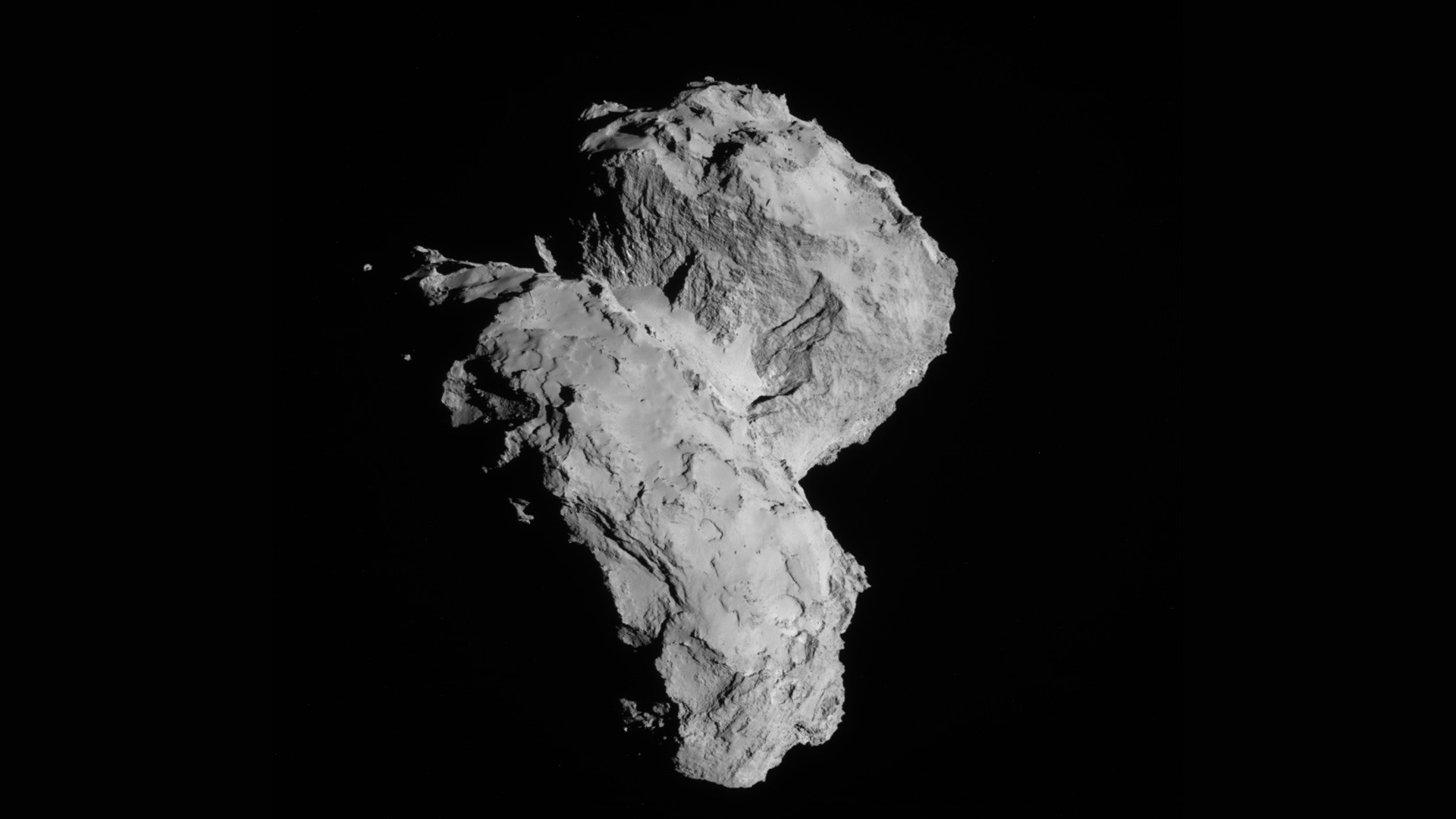Comet 67P has the building blocks of life — smells like mothballs and almonds
Comet 67P/Churyumov-Gerasimenko is rich in organic molecules that play a key role in the development of carbon-based life.

The Comet 67P/Churyumov-Gerasimenko is much richer in complex organic molecules than scientists expected, and until now, some of those molecules had never been seen around a comet.
Because comets are believed to be responsible for seeding complex molecules essential for carbon-based life on Earth, the findings could have implications for how life was kick-started on our planet.
The team, including scientists from the University of Bern in Switzerland, conducted their research using data collected by the Rosetta spacecraft and analyzed by its mass spectrometer, ROSINA, between 2014 and 2016. Rosetta and its Philae lander, which touched down on the comet, arrived at Comet 67P/Churyumov-Gerasimenko (or Chury, as scientists call it) in 2014 before Rosetta ended its mission with an intentional plunge into the comet two years later.
Related: See every comet photo (and more) from Europe's Rosetta probe
From these data, the researchers identified a series of complex organic molecules on a comet for the first time, revealing what the team calls the comet's "organics budget." The research also expands on the types of molecules that could have been delivered by comets.
"It turned out that, on average, Chury's complex organics budget is identical to the soluble part of meteoritic organic matter," Nora Hänni, a postdoctoral researcher in the Department of Space Research and Planetary Sciences at the University of Bern, said in a statement. "It, therefore, seems likely that impacting comets — as essential suppliers of organic material — also contributed to the emergence of carbon-based life on Earth."
The molecular budget of Chury is similar to the organic material raining down on Saturn from its innermost ring, as detected by a mass spectrometer onboard NASA's Cassini spacecraft, Hänni added.
Get the Space.com Newsletter
Breaking space news, the latest updates on rocket launches, skywatching events and more!
Rosetta made a more in-depth analysis of the chemical content of Chury and its larger molecules thanks to a phenomenon that occurs when comets pass close to the sun when ices within it begin to melt and erupt from their surface.
As Chury reached the closest point in its orbit to our star, the comet it became active. Ices sealed within the comet were transformed immediately from solids to gases — a process called sublimation — and are released from the surface in an outflow. This jet of gas dragged dust molecules from the surface along with it.
These particles were then heated by radiation from the sun to temperatures much hotter than those the particles experience at the surface of the comet. This means that larger molecules are released, or "desorbed" from the dust, making them available for detection and analysis by ROSINA.
What Comet Chury smells like
ROSINA's analysis revealed types of chemicals composed of many atoms, including complex organic molecules and molecules never detected in any comet before, that had previously been hidden in the comet's dust.
Amongst these were the traces of some compounds on Earth that help to form familiar fragrances.
"We found, for instance, naphthalene, which is responsible for the characteristic smell of mothballs," Hänni said. "And we also found benzoic acid, a natural component of incense,” Hänni says. “In addition, we identified benzaldehyde, widely used to confer almond flavor to foods, and many other molecules.
"These heavy organics would apparently make Chury'’s scent even more complex, but also more appealing."
Some of the other molecules, like formamide, have what is known as prebiotic functionality, meaning they assist in the synthesis of biomolecules such as amino acids and sugars.
The team put the organic budget of Chury into the wider context of the solar system and even the clouds of gas and dust that collapse to form new stars and planetary systems. This helped further support what scientists have suspected about comets like Chury for some time: that they are potential "fossil records" of the materials that formed the planets in the solar system 4.5 billion years ago.
"We do not only find similarities of the organic reservoirs in the solar system, but many of Chury's organic molecules are also present in molecular clouds, the birthplaces of new stars," Susanne Wampfler, an astrophysicist at the Center for Space and Habitability at the University of Bern, said in the statement. "Our findings are consistent with and support the scenario of a shared presolar origin of the different reservoirs of solar system organics, confirming that comets indeed carry material from the times long before our solar system emerged."
The team's research was published in June in the journal Nature.
Follow us on Twitter @Spacedotcom and on Facebook.
Join our Space Forums to keep talking space on the latest missions, night sky and more! And if you have a news tip, correction or comment, let us know at: community@space.com.

Robert Lea is a science journalist in the U.K. whose articles have been published in Physics World, New Scientist, Astronomy Magazine, All About Space, Newsweek and ZME Science. He also writes about science communication for Elsevier and the European Journal of Physics. Rob holds a bachelor of science degree in physics and astronomy from the U.K.’s Open University. Follow him on Twitter @sciencef1rst.
